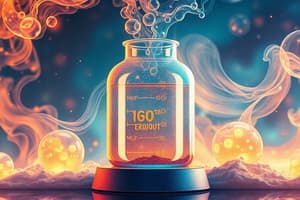Podcast
Questions and Answers
Which of the following accurately represents a characteristic of heterogeneous equilibria?
Which of the following accurately represents a characteristic of heterogeneous equilibria?
- Pure solids do not affect the position of equilibrium. (correct)
- All reactants and products are in the same phase.
- The equilibrium constant depends on the concentration of pure solids.
- The amounts of pure liquids can change the equilibrium position.
What is the main difference between homogeneous and heterogeneous equilibria?
What is the main difference between homogeneous and heterogeneous equilibria?
- Homogeneous equilibria involve reactions with varying concentrations.
- All reactants in homogeneous equilibria are in different phases.
- Heterogeneous equilibria always involve gases.
- Heterogeneous equilibria include pure solids and liquids. (correct)
When writing equilibrium constant expressions for reactions, which substances are excluded for heterogeneous equilibria?
When writing equilibrium constant expressions for reactions, which substances are excluded for heterogeneous equilibria?
- Aqueous solutions
- Solids and liquids (correct)
- Gases only
- All reactants and products
How is Kp related to Kc in reactions involving gases?
How is Kp related to Kc in reactions involving gases?
Which of the following statements about the decomposition of calcium carbonate is true?
Which of the following statements about the decomposition of calcium carbonate is true?
In the decomposition of liquid water to gaseous hydrogen and oxygen, which expression represents Kc?
In the decomposition of liquid water to gaseous hydrogen and oxygen, which expression represents Kc?
What does the equilibrium constant K represent in reactions involving solutions?
What does the equilibrium constant K represent in reactions involving solutions?
In calculating Kp from Kc, what factor must be considered?
In calculating Kp from Kc, what factor must be considered?
For the reaction 2NO2(g) ⇌ 2NO(g) + O2(g), what is the equilibrium expression Kp based on the observed pressures?
For the reaction 2NO2(g) ⇌ 2NO(g) + O2(g), what is the equilibrium expression Kp based on the observed pressures?
Given P(N2) = 0.525 atm, P(NH3) = 0.0167 atm, and P(H2) = 0.00761 atm, does this represent a system at equilibrium for the reaction N2(g) + 3H2(g) ⇌ 2NH3(g)?
Given P(N2) = 0.525 atm, P(NH3) = 0.0167 atm, and P(H2) = 0.00761 atm, does this represent a system at equilibrium for the reaction N2(g) + 3H2(g) ⇌ 2NH3(g)?
What does Δn represent in the equation Kp = Kc(RT)Δn?
What does Δn represent in the equation Kp = Kc(RT)Δn?
In the reaction 2SO2(g) + O2(g) ⇌ 2SO3(g), if Kp = 0.25 at 1100 K, how would you calculate K at the same temperature?
In the reaction 2SO2(g) + O2(g) ⇌ 2SO3(g), if Kp = 0.25 at 1100 K, how would you calculate K at the same temperature?
When is K equal to Kp according to the relationship Kp = Kc(RT)Δn?
When is K equal to Kp according to the relationship Kp = Kc(RT)Δn?
For which of the following reactions is Kp equal to Kc?
For which of the following reactions is Kp equal to Kc?
What is the main factor that affects whether Kp or Kc is used in reaction equilibrium calculations?
What is the main factor that affects whether Kp or Kc is used in reaction equilibrium calculations?
How is K calculated when Kp is already known for the reaction at a certain temperature?
How is K calculated when Kp is already known for the reaction at a certain temperature?
Flashcards are hidden until you start studying
Study Notes
Equilibrium Concepts
- Heterogeneous Equilibria: Involve reactants and products in different phases (solid, liquid, gas).
- Homogeneous Equilibria: Involve reactants and products in the same phase.
Importance of Pure Substances in Equilibria
- Pure solids and liquids are not included in equilibrium expressions because their concentrations remain constant.
Equilibrium Constants
- Kc: Equilibrium constant based on concentrations of gaseous and dissolved species.
- Kp: Equilibrium constant based on partial pressures of gases.
Conversion Between Kc and Kp
- Relationship: ( K_p = K_c (RT)^{\Delta n} )
- ( \Delta n ) is the change in the number of moles of gas: ( (\text{moles of gaseous products}) - (\text{moles of gaseous reactants}) ).
- R = 0.08206 L·atm/(mol·K), T = temperature in Kelvin.
Examples of Equilibrium Expressions
- For reactions involving gaseous species, write Kp expressions excluding pure solids and liquids.
- Example 1: For the reaction ( 2NH_3(g) + CO_2(g) ⇌ N_2CH_4O(s) + H_2O(g) ), Kp focuses on gaseous components only.
Practice Calculations
- Calculate Kp: For ( 2NO_2(g) ⇌ 2NO(g) + O_2(g) ), use given equilibrium pressures to solve for Kp.
- Determining Equilibrium: Given pressures, check if Kp reflects a system at equilibrium.
Conditions for Kp and Kc Equality
- Kp equals Kc when ( \Delta n = 0 ), indicating the number of moles of gases on both sides of the reaction are equal, causing the ( RT ) factor to cancel.
Examples of When Kp = Kc
- Reactions with equal number of gaseous moles on both sides demonstrate the equality of Kp and Kc.
Real-World Application
- Understanding equilibrium constants aids in predicting the behavior of chemical reactions under various conditions, critical for industrial processes and chemical synthesis.
Studying That Suits You
Use AI to generate personalized quizzes and flashcards to suit your learning preferences.



